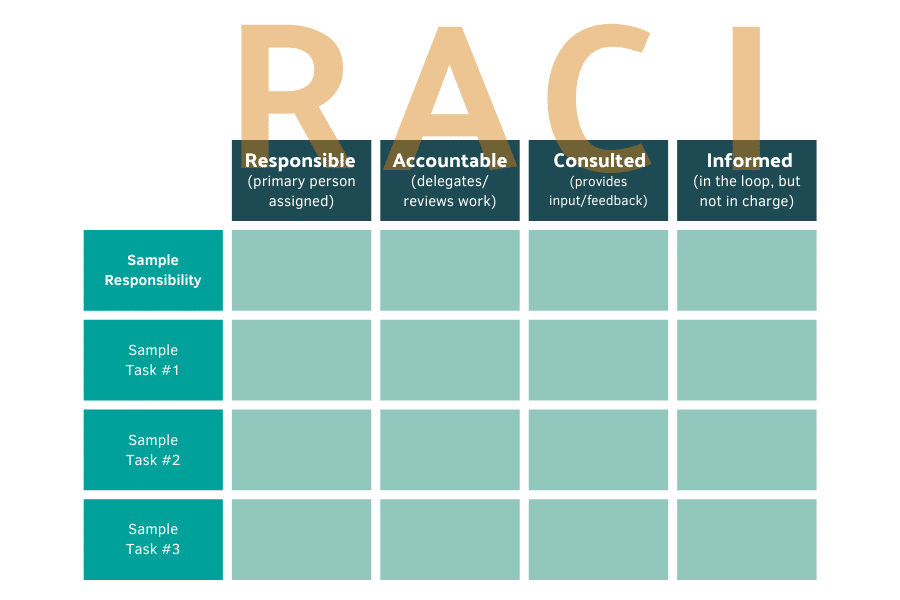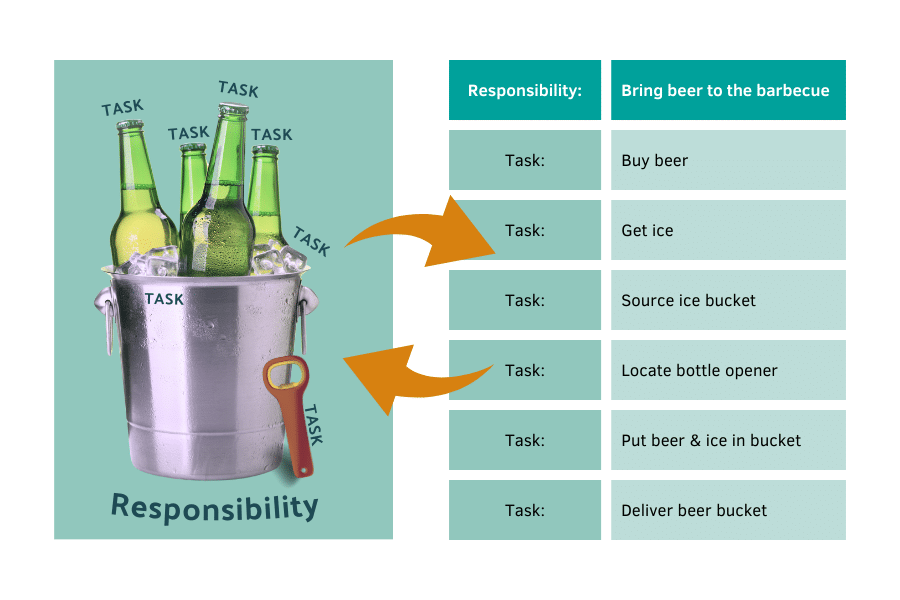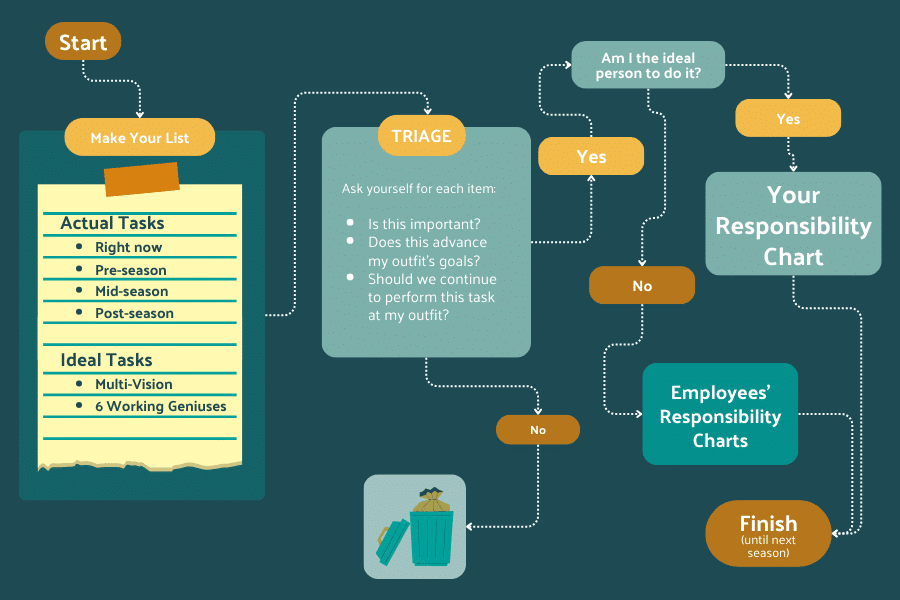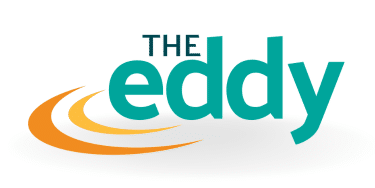Does your day-to-day work truly align with the big-picture vision for your outfit?
Responsibility charting is a powerful tool that helps align your daily grind with the ideal version of your business. (Plus, responsibility charts are the logical next step after implementing supervisor roles in your outfit’s depth chart.)
The Eddy Snowball Effect
Responsibility charting is a vital part of a well-run business. But, the exercise is most effective if undertaken after completing other foundational legwork.
In our Eddy group, the outdoor adventure industry’s only Owner & Manager peer group, we’ve invested considerable time and energy building a relevant curriculum that reflects the needs and realities of a seasonal outdoor business.
Our Eddy cohort completed the following accelerator-like “prerequisites” before undertaking responsibility charting:
6 Working Geniuses
Understanding your working geniuses means playing to your strengths. And, being familiar with your working geniuses means fewer opportunities to get bogged down with frustrations or weaknesses.
Holding a deep understanding of both your own working geniuses and those of your outfit’s top leaders will provide extra clarity as you chart responsibilities and tasks.
Zebulon’s Multi-Vision
The Multi-Vision is a Zebulon-original exercise that layers goals, planning, and accountability. Our Multi-Vision workbook tracks short-term, mid-term, and longer-term goals for both your business and your personal life – and those of your top leaders. Clearly articulating your personal and professional goals gives multi-level clarity as you chart your responsibilities.
Supervisory Roles
Intentionally developing supervisory roles in your outfit helps clarify which tasks you should delegate while you chart responsibilities.
Having a robust hierarchy of leaders, supervisors, and employees (made up of small cohorts that understand to whom they’re reporting and how often), will make the finishing stages of Responsibility Charting a breeze.
What Itch Does Responsibility Charting Scratch?
In our experience, many outfit owners and top leaders tend to feel overburdened. This is especially true if you’re ramping up for high season, scaling your business, or trying to remove yourself from operations. If you or your managers feel like you don’t have the capacity to take on any more stuff, you’re not alone.
Responsibility charting helps relieve the nagging feeling that you never make a dent in your to-do list. Responsibility charting also provides clarity: it helps you separate the wheat from the chaff, trim the fat, and recognize which items are the most mission-critical for your outfit. In turn, this frees you up to spearhead more growth and innovation, and maybe even take some more free weekends with your family.
As you follow the steps outlined below, you’ll naturally clarify who in your outfit holds responsibility for certain initiatives. You’ll also clarify who is responsible for carrying out individual tasks within those responsibilities. (Note: they’re probably different people!). From here, you’ll gain clarity on who holds ultimate authority over a decision and who should sign off on new projects.
If you’ve ever heard of RACI charts, today’s Responsibility Charting exercise is the forerunner to these project management tools. Responsibility charting is the first essential step to ensuring your whole team knows who is Responsible, Accountable, Consulted, and Informed.

An example RACI chart, designating specific team members to be responsible for, accountable for, consulted on, and informed about certain responsibilities and tasks.
Distinguishing Between Responsibilities and Tasks
A key concept to keep in mind here is the difference between larger responsibilities and smaller tasks.
Picture an ice-cold bucket of beer, and the different items it involves: a handful of beer bottles, plenty of ice, and the bucket itself. Don’t forget a bottle opener!
Now, if you’re in charge of bringing beer to this weekend’s barbecue, that’s your responsibility. Within that responsibility, there are multiple individual tasks you’ll need to complete:
- Buy the beer
- Pick up some ice
- Get a big enough bucket
- Find a bottle opener
- Put the beer on the ice early enough to avoid room-temperature brews
- Lastly, you’ve got to actually remember to bring everything to the barbecue!
All in all, that’s like a six-pack of individual tasks that comprise your larger responsibility. And boy, is that responsibility important.

Turning “Responsibility Chart” Into a Verb
So … What’s so special about responsibility charts? Aren’t they just enhanced to-do lists?
You may be thinking, “Sure, Zeb. I know how to make a to-do list. This isn’t rocket science.”
But, think again.
The most crucial aspect of responsibility charting is the journey you undertake to arrive at your final to-do list. That’s why we call it “Responsibility Charting.” (Note the “ing,” which turns this into an active process, rather than just a passive list.)
The Steps to Chart Your Responsibilities
First, it’s important to understand what your “Queen Bee Role” is within your business. If you’re not familiar with this term, we recommend reading Clockwork by Mike Michalowicz. Basically, you should pinpoint what essential role you play in your outfit (Are you the innovator? Or the growth catalyst? What about the company’s cheerleader? Perhaps you’re the ‘glue’ that holds everything together?). Knowing your Queen Bee role means you can better assess which tasks you should keep doing, which ones you should delegate, and which ones you should kick to the curb.
“A Day In the Life” Exercise
For a two week period, we recommend keeping a notepad and pen near you at all times, or leaving the notes app open on your phone. Jot down tasks as you realize you’re doing them. This allows you to take a realistic, critical look at how you actually spend your time at work.
What does a day in your work life really look like? No matter your role, log your tasks – all of ‘em – and get ready for the fun to begin. See ya in two weeks.
The “Actual” List
Once you’ve compiled an exhaustive list of what you’re currently doing, start to add other tasks that fall into your wheelhouse during other seasons. Do you handle any season-close duties? What about off-season items, like attending conferences, making projections and financial plans, or training leadership for next season? If so, add ‘em to your list.
The final product here is your “actual” list – an itemized run-down of what you actually do at work.
The “Ideal” List
Now that you have an “actual” list, start building an “ideal” list. Ask yourself, “Which items are not currently on my list, but should be?” This is where you can create your outfit’s ideal scenario. This is also where you should be extra-conscious of your Six Working Genius results and your Multi-Vision goal setting.
To get ideas flowing for your ideal list, ask yourself the following:
- What do I need to do this season to make my short-term goals a reality? And longer-term goals?
- What responsibilities and tasks play to my strengths? Weaknesses?
Triage Your Responsibility Chart
Now comes the fun part: take a scalpel to it all and begin the fruit-ninja-style triage process with a series of vital questions. For each item on your list, ask yourself:
- Is this important? Or is it busywork for the sake of busywork?
- Does this advance my outfit’s goals?
- Should we continue to perform this task at my outfit?
- If so, am I the ideal person to do it?
- If I’m not the ideal person, who is?
As you strike items from your list, add only the mission-critical ones to your employees’ lists. And as you begin to clarify your own list, organize your chart so larger responsibilities are broken down into individual tasks. Note: Some itemized tasks that fall under your own responsibilities can be – and should be – delegated to your employees’ charts.

Responsibility Charting Should Be an Ongoing Process
Now that you’ve got a clarified responsibility chart – Bravo! That’s a feat worth celebrating.
However, Responsibility Charting is an activity best performed annually (at minimum), though it’s easiest if you never stop doing it. So, don’t just sit on your haunches and recycle this year’s list when next season rolls around.
Instead, use today’s chart as the foundation for the next: carefully analyze each item, and follow the same triage process. By keeping the process ongoing, you can track progress toward goals and reflect on your changing team dynamics.
Crawl, Walk, & Run: Zebulon’s Best Practices for Responsibility Charting
If you’re starting this process from scratch, responsibility charting can feel like a hefty time commitment – and it is. It takes a decent chunk of brain power and some generous blocks of time to truly analyze which responsibilities you and your team members should hold.
However, the payoffs will far outweigh your initial time investment. The “Crawl, Walk, & Run” method is a way to build momentum with baby steps and work your way up to full implementation, bit by bit.
Crawl: Know Thyself
To start, work on becoming aware of what you currently do. Just you – no other team members.
You may be thinking, “Oh, come on. I obviously already know what I do at work!” But, please, think again. Diligently carrying out the “Day In The Life” exercise above will surely provide you with some hard truths about how you actually fill your work days.
From there, build your “Actual & Ideal” lists and slice through each item with the triage questions above. Then, start to organize your list into larger responsibilities broken down into smaller tasks.
In a nutshell: Are you in charge of bringing the beer to the barbecue? If so, have you remembered to add the bottle opener to your list?
Walk: Know Thy Leadership Team
The next step is to build responsibility charts for your entire leadership team. If you have supervisors returning for a second or third season, add them to this group too. As you whittle down your own list, make sure you’re delegating tasks and responsibilities accordingly.
Charting Responsibilities is the perfect opportunity to clearly establish your leadership team’s priorities for the upcoming season. This is also the perfect chance to provide new supervisors with a clear foundation of what you expect of them in list form.
In a nutshell: Are you really the ideal person to bring the beer bucket to the barbecue? Or should you delegate that responsibility to your General Manager?
Run: Know Thy Whole Outfit
The last step is charting responsibilities for all team members, down to the very last task and the most junior employee.
Pro Tip: We encourage showing some responsibility charts of higher-ups to lower-tier employees. At the very least, show newcomers the charts of their direct supervisors. Doing so has multiple benefits. First, new hires will gain a deeper understanding of the complexity involved in running your outfit, generating compassion and empathy for leadership. Second, by sharing the kinds of responsibilities new hires can expect if they return in future seasons, you’re demonstrating a clear growth path. This will help keep workers from abandoning the industry for “big kid jobs” down the road.
In a nutshell: If you’ve delegated the beer bucket responsibility to your General Manager, spread the wealth. Give a lower-level employee the task of finding the bottle opener. Who knows, next season they may be the ideal team member to take charge of the whole bucket!
Extra Credit: The Responsibility Charting Version
With your carefully-scrutinized responsibility chart in-hand, you may feel like you’re ready to conquer the world. If so, take things to the next level:
- Use your chart like a checklist. Print out your chart and tape it next to your computer monitor, or turn a screenshot of your list into the wallpaper on your phone. We’re certain you require your employees to follow a safety checklist before taking guests on excursions, so why not hold yourself accountable by using your Responsibility Chart like your own personal safety checklist?
- Incorporate your responsibility charts into hiring efforts. You now know exactly which tasks and responsibilities belong to each role on your team. Thus, your ability to pinpoint exactly what you’re hiring for has increased exponentially! Your job postings are practically written for you at this point.
- Log the time you spend on each item. Similar to the importance of understanding what it is you actually do at work, knowing just how much time you spend on each task can be jaw-dropping. Being able to plot your responsibilities against the amount of time you spend on them will further clarify your priorities (and total time sinks!) at your outfit.

Don’t Just Take Our Word For It …
This article covers one of the core topics discussed in our Eddy group, a non-competitive meeting space for growth-focused outfit owners and leaders. We spent over a month discussing the how’s and why’s of responsibility charting and, collectively, the group served as a sounding board and accountability squad as they began charting their own responsibilities.
If you own or lead an innovative and knowledge-hungry outfit, and would like to join our timely and relevant outfit accelerator by getting on retainer with us, reach out to us below.




